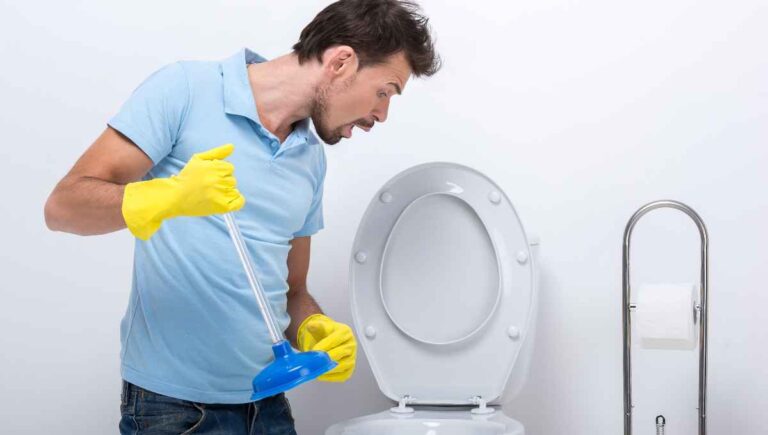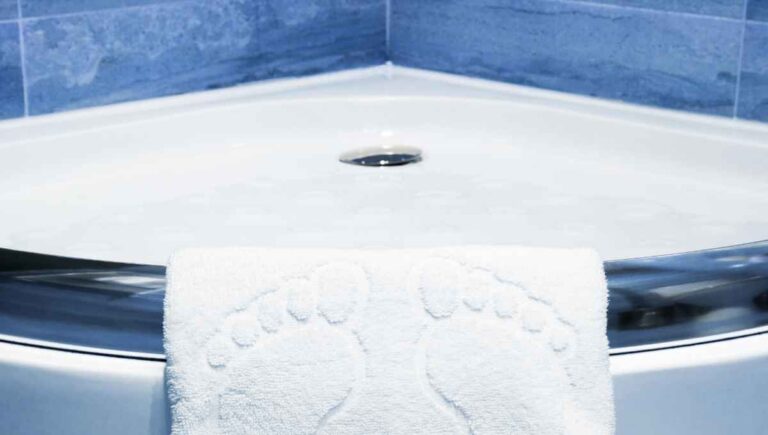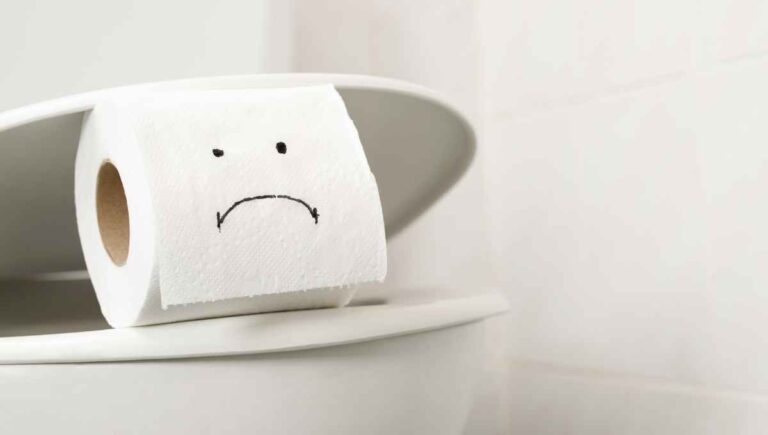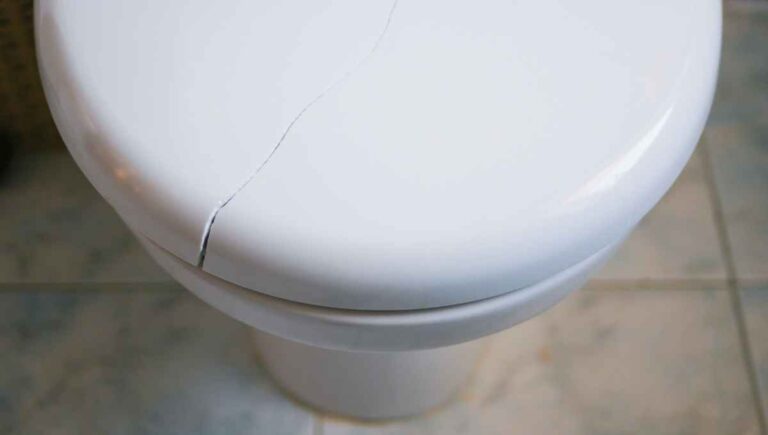Does Bleach Dissolve Toilet Paper? (Wait Before Trying This)
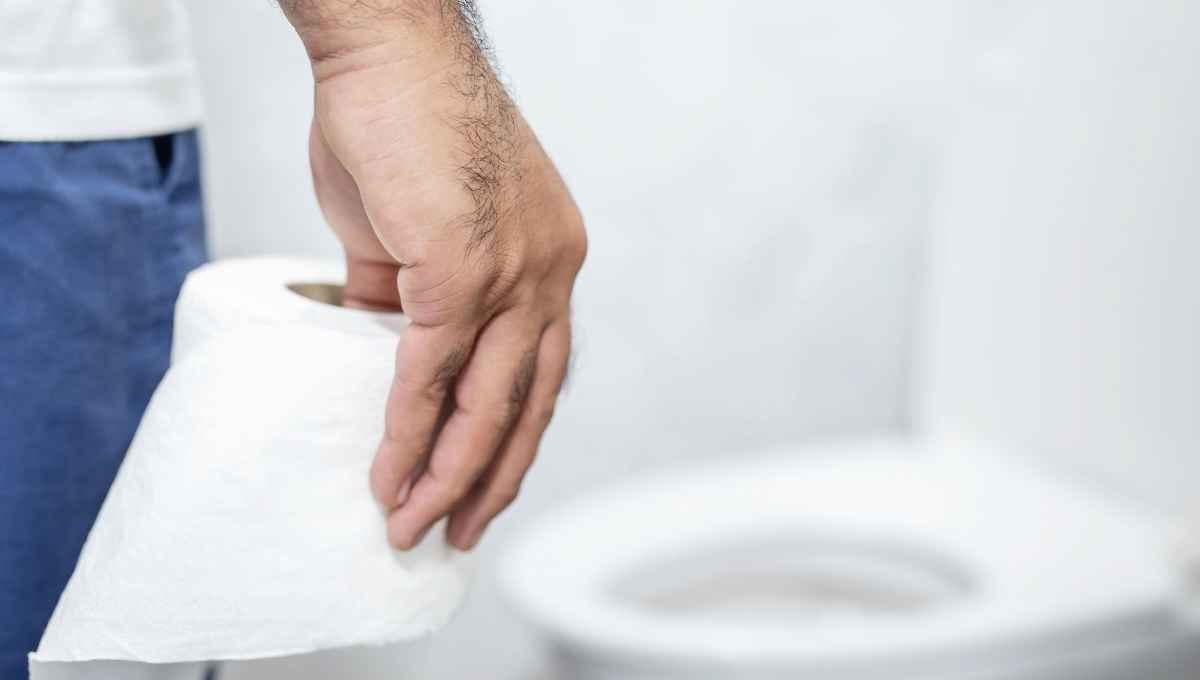
Using bleach to dissolve toilet paper may seem like a practical idea, but is it a good one? Bleach is fairly potent and can break down various types of matter, so it should be able to break down toilet paper, too, right?
Chlorine bleach does not dissolve toilet paper. Toilet paper is designed to break down over time the longer it’s exposed to water. If you’re dealing with a stubborn clog, the best solution would be to use a plunger or snake to break up the clog or call a licensed plumber.
There are some concerns with using bleach in the toilet. Bleach is a strong chemical that is irritating to the skin and eyes. Bleach can also be harmful if you pour too much of it down the drain in some cases.
But don’t worry, we’ll show you some safer alternatives and how to properly clear a toilet paper clog.
This post contains affiliate links. This means Household Blogger may earn a commission should you make a purchase using any of our links. Please refer to our full affiliate disclosure policy for full details.
Here’s a Quick Pro Tip!
Chlorine bleach is often used by professional cleaners and plumbers, however, certain precautions should be taken. There are safer and more environmentally friendly options as well.
Here are some products we suggest from Amazon.com:
1. Cloud Paper Bamboo Toilet Paper: Bamboo paper breaks down naturally and much faster than paper made with other woods that have been chemically bleached. It also won’t clog as often.
2. Dawn Apple Blossom Dishwashing Liquid: Dawn dish soap is very helpful in unclogging a drain. This particular one is great because it adds a nice smell to mask any orders from a clogged toilet.
3. Omont Drain Clog Remover Tool: This tool helps you get the clog out manually without using a plunger or chemical solutions. It’s also an inexpensive solution and can be used for any drain in the house.
Using Bleach
Bleach should be used with caution. Bleach is very strong and is great at cleaning, but is also very dangerous if not handled properly. Let’s discuss if it’s a good idea to use!
Does Bleach Melt Toilet Paper?
Toilet paper breaks down best with acidic cleaners. Bleach is a base that is good at breaking down acidic compounds like hair. Thus, bleach can aid in breaking down toilet paper, but only acidic parts of the paper.
Toilet paper breaks down in the water, but a wad of toilet paper will take more time to break down than a single sheet.
Vinegar and baking soda are good alternatives to speed up toilet paper breakdown. If the clog is not budging, call a professional plumber.
Does Bleach Dissolve Toilet Paper?
Bleach may break down certain components of toilet paper, but water and other acidic solutions work best to completely dissolve toilet paper. Vinegar is a good alternative because it is highly acidic.
Vinegar and baking soda are popular homemade drain cleaners because of their effectiveness.
Plumbers often suggest this as well as hot water to break down clogs in toilets, even those caused by large amounts of toilet paper.
Will Bleach Break Down Toilet Paper?
Bleach will break down parts of toilet paper, and when mixed with water, the combination can break down the paper. Water alone also breaks down toilet paper. If you have a large clog of toilet paper, it is best to use an acidic cleaner.
It is not suggested you use bleach regularly to break down toilet paper in toilets with septic tanks. There is even a cup fill limit of how much you can use at a time.
Plumbers suggest you use two or three cups to clear a drain.
Will Bleach Unclog a Toilet?
Bleach can unclog a toilet. It’s suggested you use three to four cups and let it sit in the toilet for 10 minutes. Then flush the toilet, and the clog should flush out. If you have a septic tank, this is not suggested.
Septic tanks can only take the occasional small amounts of bleach. You can try using only a cup of bleach instead or vinegar and baking soda.
Just be sure not to mix the vinegar and baking soda with the bleach, and be sure any bleach is washed out of the toilet first.
How Long Does it Take Bleach to Unclog a Toilet?
If you use three to four cups of bleach, let it sit for 10 minutes before flushing out the clog. If you have a septic tank, you are limited to one cup or less of bleach, so it is not suggested for homes with septic tanks.
Another effective solution is vinegar and baking soda. Turn off the water to the toilet and flush if you can to drain. If it is not draining at all and could overflow, don’t flush. Call a plumber instead.
After the toilet is drained as much as it can be, pour baking soda down the toilet and let sit for 10 minutes.
Then pour vinegar down the toilet and let it sit for ten minutes. Then flush.
How Much Bleach Does it Take to Unclog a Toilet?
It’s best to use 3 to 4 cups of bleach to unclog a toilet. However, do not use more than one cup of bleach if you have a septic tank. If your toilet will not drain at all, call a plumber. After you’ve let the bleach break down the clog, flush a couple of times to rinse away the bleach.
When you use pure Chlorine bleach, it is suggested you use gloves and protective clothing. Other forms of bleach, like hydrogen peroxide, are safer to use.
If you want to save money, you can use vinegar and baking soda to unclog a toilet.
Do You Have to Dilute Bleach to Unclog a Toilet?
You do not have to dilute bleach to unclog a toilet. It takes 3 to 4 cups of undiluted bleach to unclog a toilet. It is not good for the toilet to do this too often, and if you have a septic tank, you should use one cup or less of bleach.
Especially if you have a septic system, but even if you don’t, it’s a good idea to use vinegar instead because it’s safer and effective at unclogging drains.
You put a cup full of baking soda in a drained toilet and then pour a cup of vinegar down the drained toilet and let it fiz for 20 minutes.
Then, you should be able to flush out the clog.
How Do You Unclog a Toilet with Bleach?
To unclog a toilet with bleach, drain the toilet by turning off the water supply valve and flushing the toilet. Then pour three to four cups of bleach into the toilet drain. Let it sit for ten minutes, and then flush the toilet.
If it doesn’t drain before applying the bleach, turn off the water and do not flush the toilet. Then call a plumber. If you keep flushing, the toilet will overflow.
You also try using a plunger before calling a pumper to see if the clog will move through.
What are the Advantages of Using Bleach to Unclog a Toilet?
The biggest advantage of using chlorine bleach to unclog a toilet is that bleach is very inexpensive. It cost less than a dollar for three or four cups of bleach that’s suggested to use for a clog.
If you have a septic tank, it’s not good to use more than one cup at a time, and it’s suggested you do not pour chlorine bleach down the drain on a regular basis.
You can use vinegar and baking soda to unclog a toilet as a safer alternative.
You might also enjoy our post on Does Charming Clog Your Toilet
Bleach Damage
Bleach is a strong chemical, and therefore, it’s effective in killing germs and bacteria. Unfortunately, it can also damage household items and can be dangerous to handle. Let’s discuss.
Does Bleach Damage Toilet Bowls?
Chlorine bleach can damage toilet bowls, especially if the bleach is used often and undiluted. Porcelain toilets are not damaged as easily, but toilets with an outward enamel can be disintegrated by bleach over time and cause rust.
Bleach can also damage most things it comes in contact with, so be careful when handling it. Also, be careful not to mix it with ammonia. This creates a poisonous gas!
Ammonia is very effective in cleaning the toilet and loosening blockages, but make sure the two never mix.
What Happens if You Leave Bleach in a Toilet Too Long?
Leaving bleach in the toilet for more than a night can eat through the enamel and cause rust stains. It can also mix with the ammonia left behind from dried urine, but this is more of a concern on the outside.
It’s more concerning if you put chlorine bleach in the toilet tank because it can erode the fixings in the tank, and you will have to replace many of the parts in your toilet.
It’s best to leave bleach in the toilet bowl for only 10 minutes while it disinfects and dissolves clogs. Water will do the rest of the work without causing more harm.
Does Bleach Turn the Toilet Yellow?
If bleach is left on a toilet for too long, it can eat through the enamel and rust the metal underneath. This can create a yellowing color. It can also have a bad reaction to other cleaning solutions.
It is important that you do not mix bleach with any other cleaning product. It can also create a poisonous gas if mixed with ammonia found in dried urine.
It’s best to have bleach in the toilet bowl for only 10 minutes and then flush it to rinse it.
Alternatives
Bleach is effective at cleaning, and many people often try using it to unclog toilets. However, it can come with negative effects. Here are some alternatives to try instead:
How Do You Unblock a Badly Clogged Toilet?
First, manually remove what you can by plunging out the clog or using a metal snake drainer. You can use a metal wire hanger to snake out the clog. You can use vinegar and baking soda if the toilet still seems clogged.
If the toilet is not draining at all, call a plumber. One way to find out if it’s not draining is to turn off the water from the supply line next to the toilet and then flush.
If your toilet is already overflowing or near to overflowing, do not flush the toilet.
What is the Best Liquid to Unclog the Toilet?
Vinegar is an effective and safe solution to unclog a toilet. You can use a mixture of baking soda and vinegar. First, pour about a cup of baking soda into a drained toilet bowl and follow with about a cup of vinegar.
Let the fizzy solution sit for 20 minutes before flushing. If the drain is still not cleared, repeat that process. You can also use a plunger or drain snake to manually remove the clog.
If the toilet is not draining at all, call a plumber.
You might also enjoy our post on Does Bounty Make Toilet Paper
What Chemical Will Dissolve Toilet Paper?
Water is the most effective at dissolving toilet paper. If you have a clog with mostly toilet paper, pour hot water into the toilet, let it sit for a while, and then flush. If you are still having issues, try baking soda and vinegar.
It’s also best to start by plunging the toilet or manually removing the clog with a drain snake. Then follow with hot water.
It might be best to call a plumber if you cannot reach the clog or the toilet is not draining at all.
Does Hot Water Dissolve Toilet Paper?
Hot water is the best solution to dissolve toilet paper. Toilet paper is made with the intention of being dissolved by water. When you add hot water to a clog of toilet paper, it speeds up the process of dissolving.
Be sure not to add boiling water to a toilet bowl. Boiling water harms porcelain, and other materials toilets are typically made of.
After you add hot water to the toilet paper, it may take some time to dissolve. One ply of toilet paper dissolves the fastest.
Does Epsom Salt Dissolve Toilet Paper?
Epsom Salt is another great alternative to bleach for dissolving toilet paper and breaking up clogs in the toilet. Epsom salt is often used to soften bath water, but the fizzy reaction it has with water can work through a clog too.
Start by pouring one cup of Epsom salt on the drain and follow with hot water. Let the mixture sit for 30 minutes, allowing the salt to work its way through.
Then pour another cup of Epsom salt, follow with hot water, and wait a few more minutes before flushing. Some overflow might occur. Keep old towels around just in case.
Does Drano Dissolve Toilet Paper?
It is not suggested that you use Drano in the toilet to dissolve a clog of toilet paper. Drano is very abrasive and can damage the pipes. It is also a basic cleaner, and toilet paper is better dissolved by an acid.
Simple hot water or vinegar is best to dissolve toilet paper because of the acidity in both. Pour hot water into the toilet bowl, leave it for a while, and come back to flush.
If it is still not cleaned out, try a cup or more of vinegar and let it sit for 20 minutes before flushing it down with more hot water.
Does Vinegar Dissolve Toilet Paper?
Vinegar is very effective at dissolving toilet paper because it is strongly acidic. Acid breaks down toilet paper completely, while a base will only break down some components of the paper.
Water has a mix of both, so it’s best to follow the vinegar with hot water if you are clearing out a clog in the toilet.
Adding baking soda before pouring the vinegar helps because the mix creates a fizzing effect that quickly breaks down the paper.
You might also enjoy our post on How Long Should Your Toilet Paper Last
Does Coke Dissolve Toilet Paper?
Coke, or other acidic soft drinks, are great for breaking down toilet paper. The carbonation also works like baking soda and vinegar mixed together because of the fizzy reaction, which cuts through toilet paper faster.
Pour the coke into the drain and allow it to soak for about 20 minutes before following with hot water.
Studies have shown that RC Cola is the most acidic soft drink and the second most acidic beverage, right next to lemon juice.
Does Aspirin Dissolve Toilet Paper?
Aspirin does help dissolve toilet paper. If you are using aspirin to dissolve a clog in your toilet, you can follow with warm water and dish soap after the aspirin has had time to work through the clog.
Aspirin is not more effective than other solutions. However, in a pinch, you can use it to help break up a clog. You can also follow it with dawn dish soap.
The soap is also good at unclogging toilets and helps with unpleasant smells.
Will a Toilet Paper Clog Eventually Dissolve?
A toilet paper clog will dissolve on its own with just the water in the pipe and toilet bowl, but it could take over a week depending on the size of the clog and how often you flush the toilet.
If you add hot water to the clog, it will dissolve much faster and prevent unpleasant smells from the clog.
You can also add vinegar, scented Epsom salts, or dawn dish soap to help break down the clog and help with the smell.
Will Toilet Paper Unclog Itself?
If the toilet paper is stuck in a water pipe or in your toilet drain and the water is still flushing through it, the paper will eventually break up and unclog without any extra assistance. However, if water is not getting to the clog, it will not come loose.
Pour hot water down the drain or in the toilet bowl to help the clog come out faster and flush after thirty minutes. Repeat this process until the toilet flushes normally again.
You can also add dawn dish soap to help the clog and the smell. Toilet seat covers are made the same way.
You might also enjoy our post on Can You Flush a Toilet Seat Cover
Related Questions
How Long Does it Take for Toilet Paper to Decompose?
The rate at which toilet paper decomposes depends on its environment. If it is flushed down a toilet, water will dissolve the toilet paper before it starts to decompose. Some toilet paper is made from chemicals that do not decompose naturally.
If you want to purchase toilet paper that decomposes faster and naturally, you can buy toilet paper made with 100% organic materials, like bamboo.
Bamboo wood makes good environmentally friendly products because it grows quickly and is just as useful as other woods.
Does Bleach Dissolve Paper Towels?
Bleach will break down certain parts of a paper towel, but it will not completely dissolve a paper towel. However, if you have a clogged drain caused by paper towels, pour undiluted bleach on the drain and wait 15 minutes before flushing.
It’s best to never flush a paper towel down a toilet because a single sheet takes eight days to break down in the water.
It will take much longer if you have a clog of paper towels. Also, if you have a septic tank, do not flush more than one cup of bleach when trying to unclog a toilet.
Final Thoughts
I hope this article helps you move forward in your unclogging task. Using bleach to unclog the toilet is generally not the best course of action.
While professional cleaners and plumbers often use bleach, pouring it down your toilet to clear clogs may do more harm than good.





